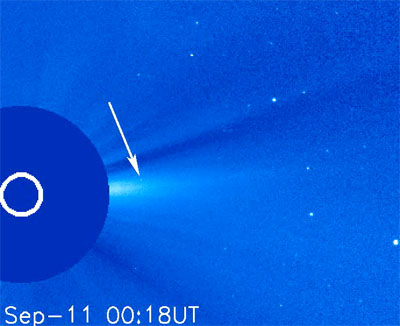26 September 2007

Credit: SOHO (NASA/ESA)
The NASA/ESA Solar and Heliospheric Observatory (SOHO) spacecraft discovered a new comet. SOHO discovered over 1350 comets, but its latest discovery is peculiar as the spacecraft spotted it twice before. This is SOHO's first periodic comet.
The comet was detected by SOHO’s Large Angle and Spectrometric Coronagraph Experiment (LASCO). Many other SOHO comets are believed to be periodic.
Astronomers have recorded thousands of comets, but only around 190 are classified as periodic. The most famous periodic comet is Halley’s comet, returning to the vicinity of Earth every 76 years, with its last close pass to the Sun taking place in 1986.
The orbit of SOHO’s new comet is much smaller, with a period of approximately 4 years. It was first detected in September 1999, and then again in September 2003. In 2005, German PhD student, Sebastian Hoenig, suggested that the two comets may be the same objects as their orbits are very similar.
To verify his postulate, Hoenig calculated a combined orbit for the comet, and consequently predicted that it would return on 11 September 2007. Sebastian's prediction proved to be extremely accurate as the comet reappeared in SOHO's LASCO images right on schedule, and has now been officially designated P/2007 R5 (SOHO).
Some astronomers are rather puzzled as the comet does not show some essential cometary characteristics, such as the tail and coma of gas and dust. Some scientists speculated if it were actually an asteroid. However, P/2007 R5 (SOHO) did exhibit some cometary phenomena. As it approached the Sun to within 7.9 million km, around 5% of the distance from Earth to the Sun, they observed it brighten by a factor of around one million. This is common for comets.
So P/2007 R5 (SOHO) appears to behave like a comet, even though it does not really look like a typical comet. “It is quite possibly an extinct comet nucleus of some kind,” said Karl Battams, who manages SOHO's comet discovery programme. Extinct comets are those that have shed most of their volatile icy constituents and only little material remains to form a tail or coma. They are believed to be common objects amongst the celestial bodies orbiting near the Sun.
The comet faded as rapidly as it flared, and soon became too faint for SOHO's instruments to observe it. Estimates show that P/2007 R5 (SOHO) is probably only 100-200 metres across. It is now an extremely difficult target for Earth-based observers. Astronomers are eagerly anticipating its next return in September 2011.
Further Reading
ESA Press Release
http://www.esa.int/esaSC/SEMAU2C1S6F_index_0.html
ESA
www.esa.int/
Aymen Mohamed Ibrahem
Senior Astronomy Specialist